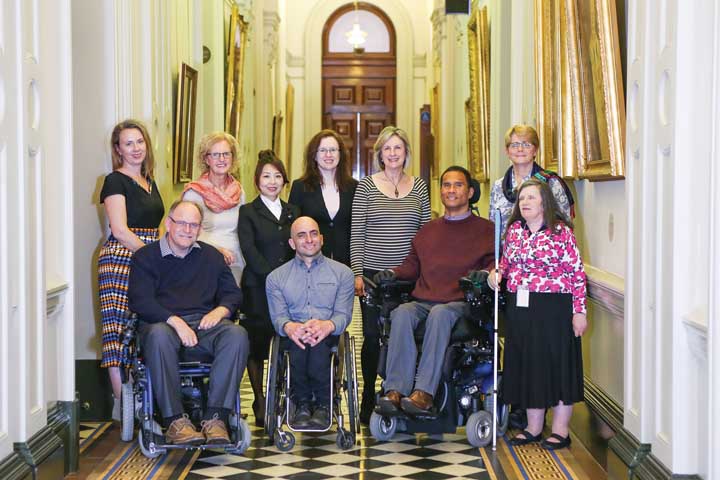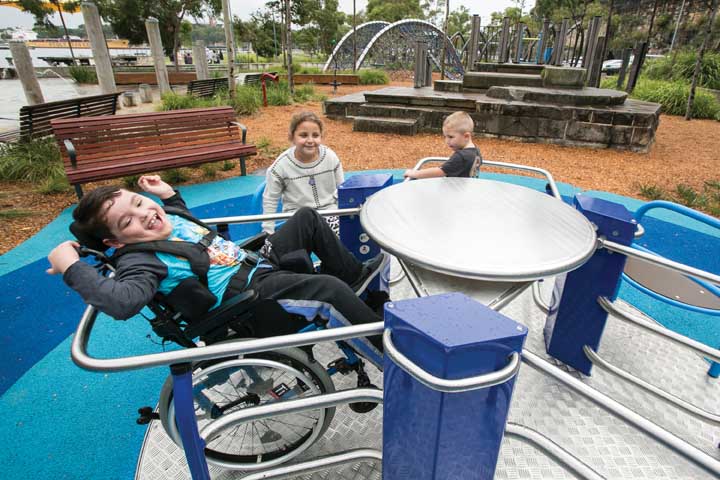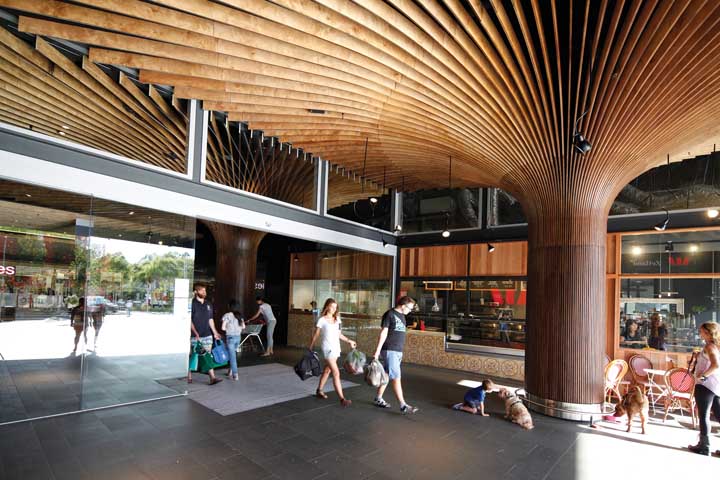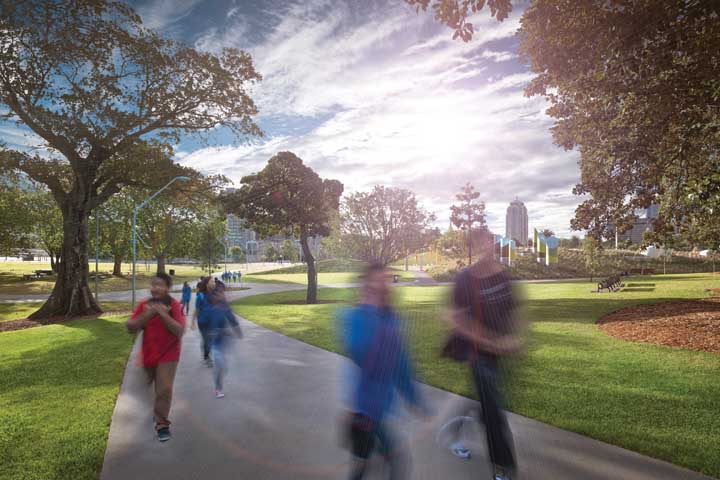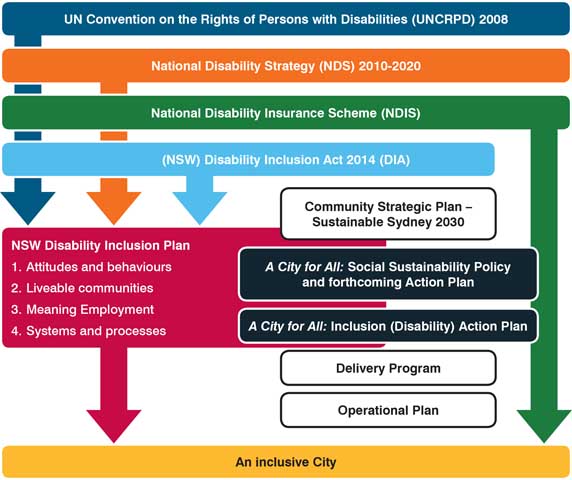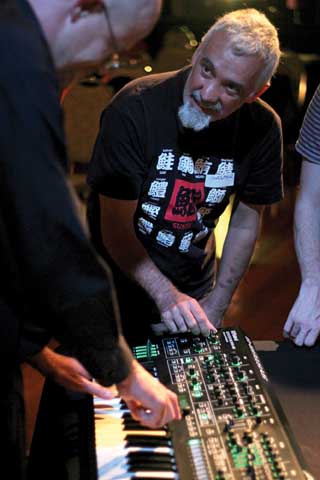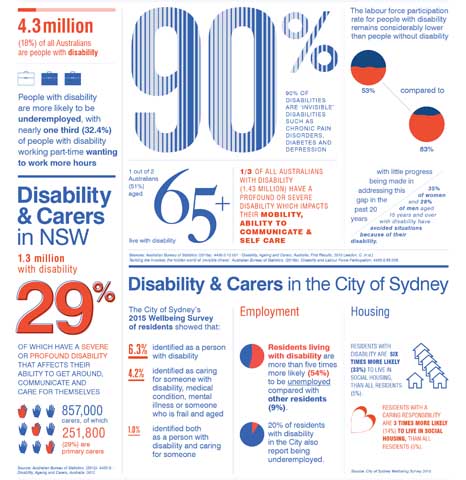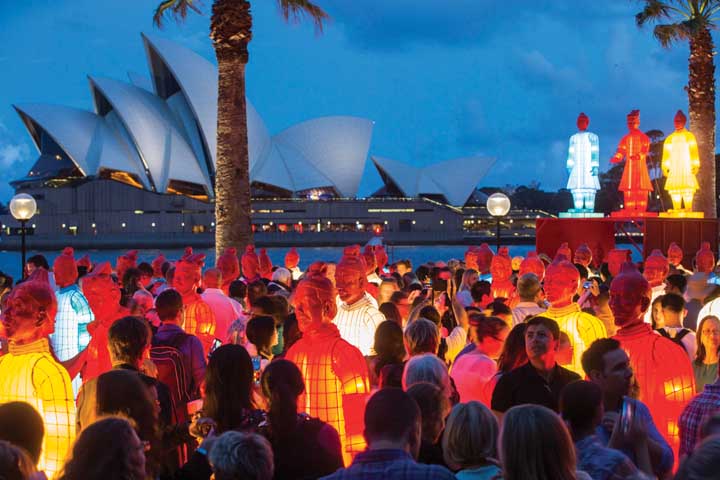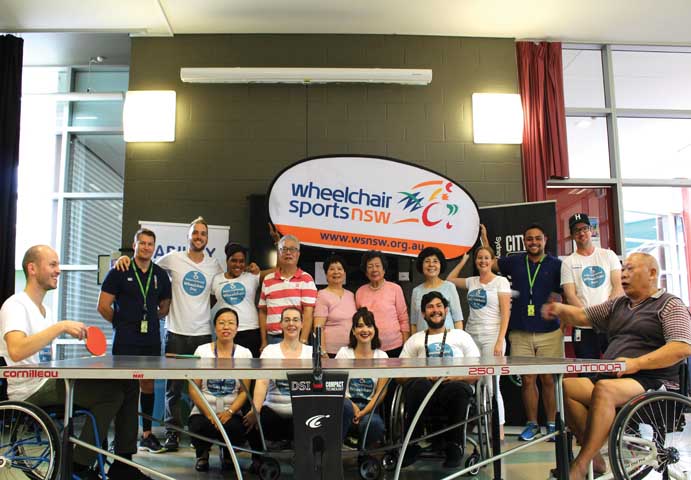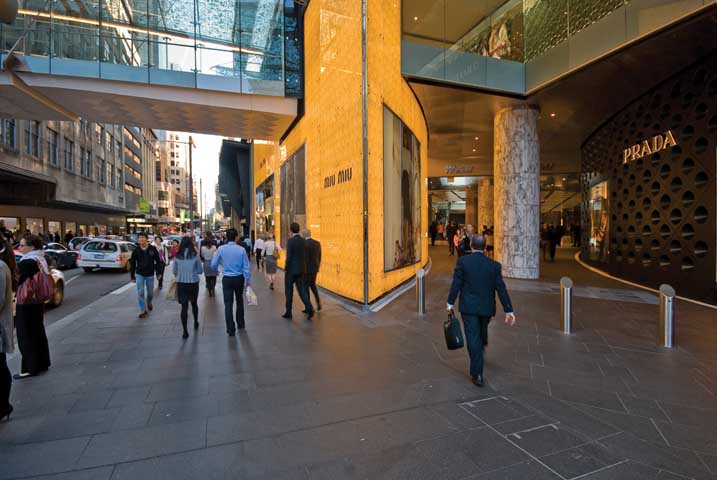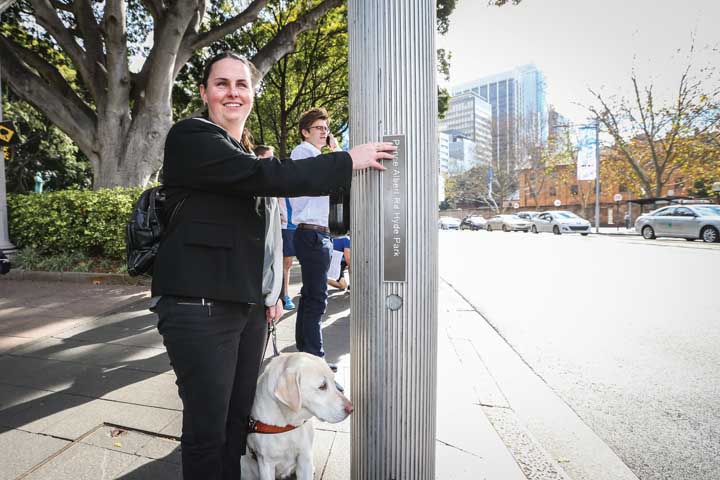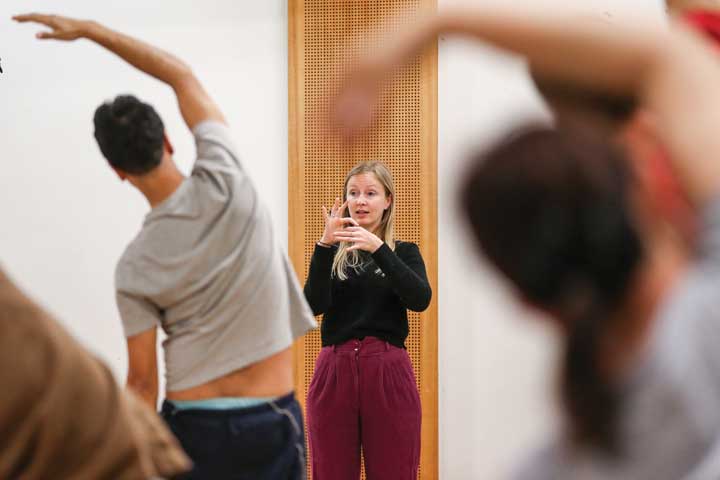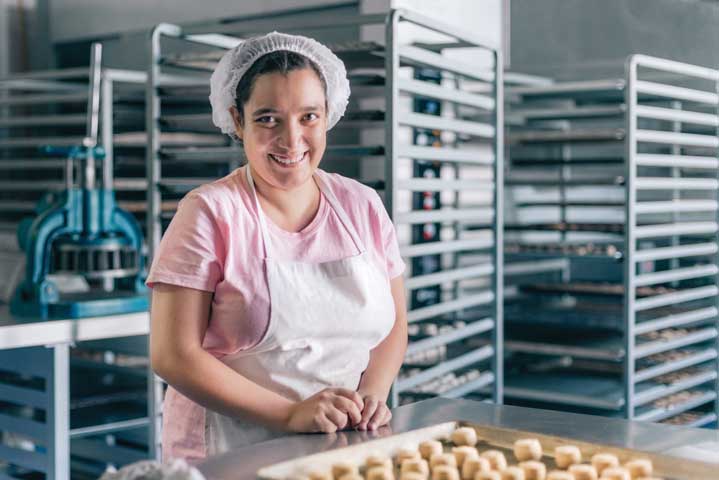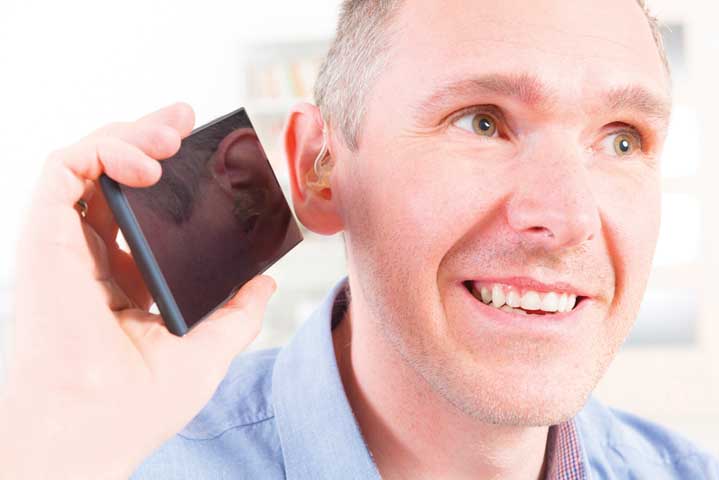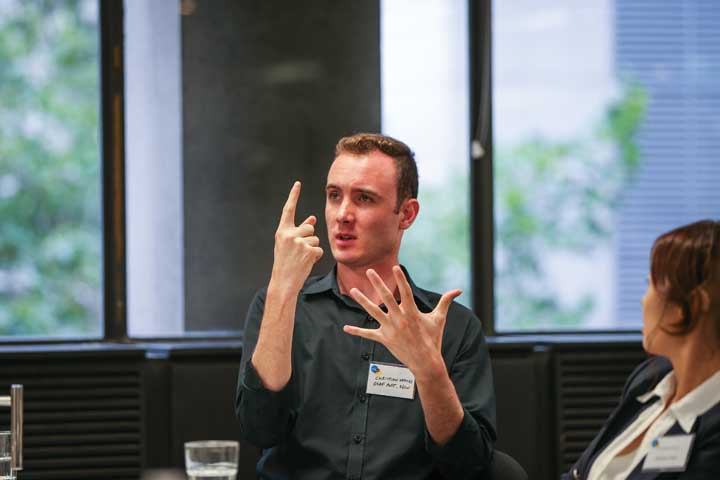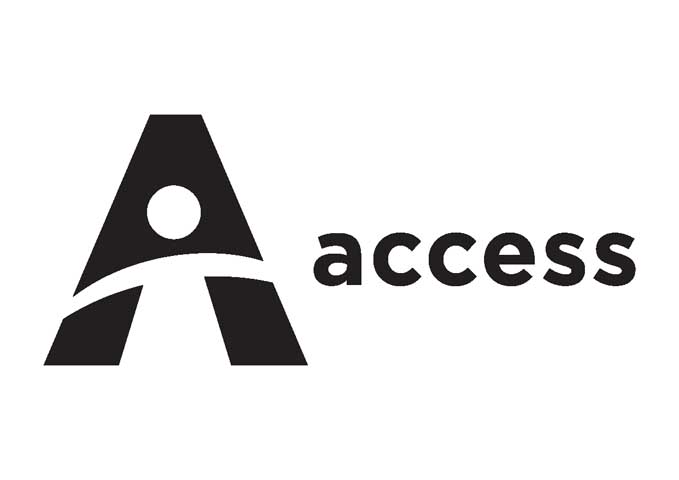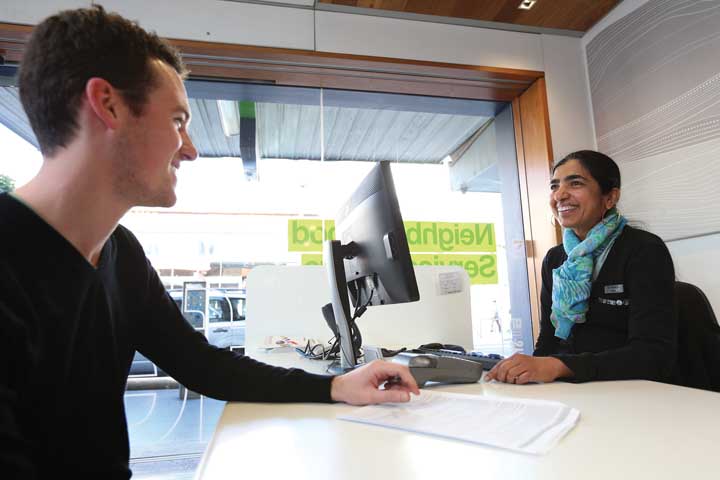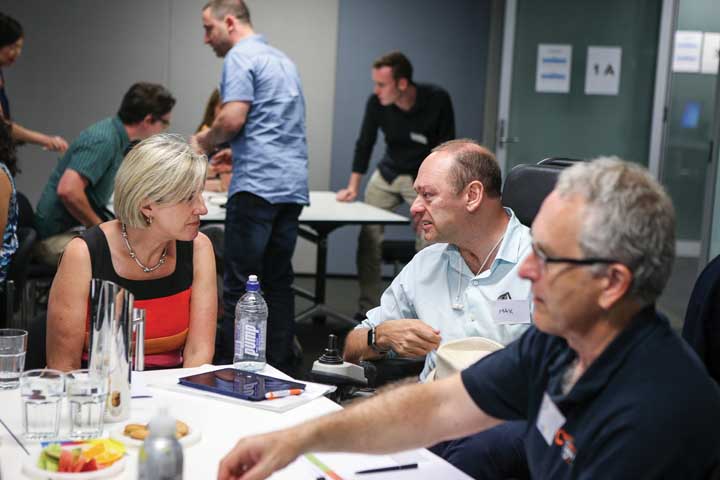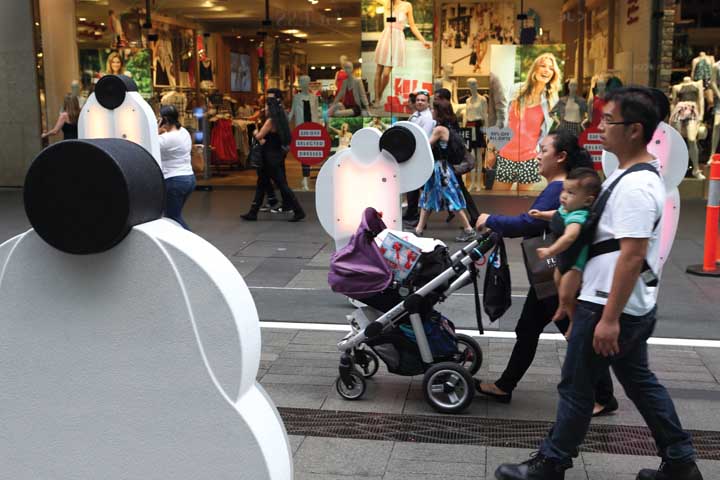Direction 1: Positive community attitudes and behaviours
Harmony and Social Cohesion
Outcomes/Objectives
City of Sydney Staff are disability aware and confident, and have access to specialists training and development opportunities to deliver inclusive built environments and ensure our communications and services are accessible and inclusive of people with disability. Staff will have the skills to meet requirements under the Commonwealth Disability Discrimination Act 1992 and the NSW Disability Inclusion Act 2014 and deliver services that consider inclusion, not just compliance.
Actions: What we will do
1. Continue to implement a program of disability awareness and confidence training for City of Sydney staff.
Measures
- Number and percentage increase in staff completing disability awareness training.
- Number of staff completing relevant specialist training.
- Percentage of staff with disability who agreed their colleagues have good disability awareness.
Responsibility
Corporate HR, Organisational Capability, Social Programs and Services
Timing
Ongoing
Integrated Planning and Reporting Reference Framework
Sustainable Sydney 2030 Objective:
6.2 Our city is a place where people are welcomed, included and connected.
Outcomes/Objectives
Positive community attitudes towards people with disability and a lived experience of mental health issues are enhanced through City of Sydney programs that foster greater awareness, understanding and respect.
Actions: What we will do
2. Use the City's mainstream media channels, publications, events and sponsorship opportunities to promote inclusion of people with disability.
Measures
- Percentage of people featured in our publications with a visible disability.
- Percentage of people who attended events who reported increased understanding and awareness of the importance of inclusion.
Responsibility
Media and Communications, Social Programs and Services
Timing
2017-2021
Integrated Planning and Reporting Reference Framework
Sustainable Sydney 2030 Objective:
6.2 Our city is a place where people are welcomed, included and connected.
Outcomes/Objectives
Positive community attitudes towards people with disability and mental health conditions are enhanced through City of Sydney programs that foster greater awareness, understanding and respect.
Actions: What we will do
3. Develop community programming aimed at fostering positive community attitudes towards people with disability and people with mental a lived experience of mental health issues.
Measures
- Percentage of people who attended City of Sydney events who reported increased understanding and awareness of the importance of social inclusion.
Responsibility
Creative City, Social Programs and services
Timing
Ongoing
Integrated Planning and Reporting Reference Framework
Sustainable Sydney 2030 Objective:
6.2 Our city is a place where people are welcomed, included and connected.
Direction 2: Liveable communities
Accessible places and spaces
Outcomes/Objectives
Public domain infrastructure is accessible, its design, maintenance and management enables people with disability to travel through the City with dignity and independence.
Actions: What we will do
4. Continue to improve the accessibility of the public domain for people with disability and older people, through renewal programs, upgrades and new capital projects, including identifying opportunities to provide designated quiet spaces for people with sensory processing disorders.
Measures
- Percentage of footpaths throughout the Liveable Green Network with accessible kerb ramps.
- Number and percentage signalised pedestrian crossings in the local that are in braille and raised letter signs (tactile sign network).
- Number of designated quiet spaces in the public domain including in City community facilities.
Responsibility
City Infrastructure and Traffic Operations, City Design and Social Programs and Services
Timing
Ongoing
Integrated Planning and Reporting Reference Framework
Sustainable Sydney 2030 Objective:
4.1 The city and neighbouring areas have a network of accessible, safe, connected pedestrian and cycling paths integrated with green spaces.
Outcomes/Objectives
Public domain infrastructure is accessible, its design, maintenance and management enables people with disability to travel through the City with dignity and independence.
Actions: What we will do
5. Explore the provision of charging points for personal devices such as phones, electric bikes and mobility scooters in the public domain and community facilities where appropriate.
Measures
- Number new mobile charging stations provided by the City.
Responsibility
City Infrastructure and Traffic Operations, Social Programs and Services
Timing
2017-2020
Integrated Planning and Reporting Reference Framework
Sustainable Sydney 2030 Objective:
4.1 The city and neighbouring areas have a network of accessible, safe, connected pedestrian and cycling paths integrated with green spaces.
Outcomes/Objectives
Public domain infrastructure is accessible, its design, maintenance and management enables people with disability to travel through the City with dignity and independence.
Actions: What we will do
6. Deliver a new City centre all-inclusive play space.
Measures
- Number of inclusive play opportunities in the City of Sydney area.
Responsibility
City Projects
Timing
2020-2021
Integrated Planning and Reporting Reference Framework
Sustainable Sydney 2030 Objective:
4.1 The city and neighbouring areas have a network of accessible, safe, connected pedestrian and cycling paths integrated with green spaces.
Outcomes/Objectives
Public domain infrastructure is accessible, its design, maintenance and management enables people with disability to travel through the City with dignity and independence.
Actions: What we will do
7. Review the current provision of mobility parking spaces in the City of Sydney, and develop strategies to maximise the access and inclusion outcomes associated with mobility parking.
Measures
- An audit of existing on street mobility parking spaces is completed and strategies identified,
- Number of spaces within 200m of key social infrastructure (hospitals, community facilities, village shopping precincts).
Responsibility
City Access
Timing
2017-2019
Integrated Planning and Reporting Reference Framework
Sustainable Sydney 2030 Objective:
4.1 The city and neighbouring areas have a network of accessible, safe, connected pedestrian and cycling paths integrated with green spaces.
Outcomes/Objectives
Public domain infrastructure is accessible, its design, maintenance and management enables people with disability to travel through the City with dignity and independence.
Actions: What we will do
8. Continue to provide information about the locations of mobility parking spaces in the City, and include additional information about their features.
Measures
- Percentage of on street mobility parking spaces reflected on the City of Sydney website.
Responsibility
City Access
Timing
Ongoing
Integrated Planning and Reporting Reference Framework
Sustainable Sydney 2030 Objective:
4.1 The city and neighbouring areas have a network of accessible, safe, connected pedestrian and cycling paths integrated with green spaces.
Outcomes/Objectives
Public domain infrastructure is accessible, its design, maintenance and management enables people with disability to travel through the City with dignity and independence.
Actions: What we will do
9. Advocate to commercial parking operators to develop strategies to improve the information provided about accessible parking spaces, booking systems and the accessibility of key infrastructure in parking stations.
Measures
- Number of off street commercial parking stations that provide detailed information about accessible spaces.
Responsibility
Social Programs and Services
Timing
2019-2021
Integrated Planning and Reporting Reference Framework
Sustainable Sydney 2030 Objective:
4.1 The city and neighbouring areas have a network of accessible, safe, connected pedestrian and cycling paths integrated with green spaces.
Outcomes/Objectives
Accessible City of Sydney community facilities and venues provide the foundation of inclusive participation.
Actions: What we will do
10. Develop a plan to provide hearing augmentation systems in the City's community facilities and venues where appropriate and as recommended by Australian Standards.
Measures
- Number and percentage of City of Sydney Community facilities and venues with appropriate hearing augmentation plans.
Responsibility
City Property
Timing
2019-2020
Integrated Planning and Reporting Reference Framework
Sustainable Sydney 2030 Objective:
6.4 There is equitable access to community facilities and places, parks and recreational facilities to support wellbeing in daily life
Outcomes/Objectives
Emerging technologies empower greater independence for all people, including people with disability, to navigate and access public spaces.
Actions: What we will do
11. Maintain the online accessibility map and explore the use of emerging technologies to empower all people, including people with disability, to independently navigate and access public spaces.
Measures
- Number of hits per month.
- Feedback on accuracy of map data.
Responsibility
Social Programs and Services, Strategic Planning
Timing
2017-2021
Integrated Planning and Reporting Reference Framework
Sustainable Sydney 2030 Objective:
4.1 The city and neighbouring areas have a network of accessible, safe, connected pedestrian and cycling paths integrated with green spaces.
Outcomes/Objectives
Local businesses are more accessible and inclusive to people with disability, parents with prams and older people, as well as their friends and families.
Actions: What we will do
12. Provide access to grants, guidelines and training to encourage local businesses in the City of Sydney to develop their business to be more inclusive and accessible to people with disability and explore recognising inclusive businesses through awards.
Measures
- Number of grants awarded.
- Number of resources distributed.
- Commentary of access improvements achieved through grant/awards.
Responsibility
City Business and Safety, Media and Communications, Social Policy and Programs, Strategic Planning
Timing
2018-2021
Integrated Planning and Reporting Reference Framework
Sustainable Sydney 2030 Objective:
6.3 Local economies are resilient, meet the needs of their community, and provide opportunities for people to realise their potential.
Diverse housing tenures and types
Outcomes/Objectives
More housing in the City of Sydney is universally designed. It will meet the needs of people with disability and support people to age in place.
Actions: What we will do
13. Encourage delivery of housing in the local area that is universally accessible for people and meets the Gold Standard of the Liveable Housing Australia Design Guidelines.
Measures
- Number of new dwellings delivered, through City planning framework that is Universally Designed (meets Liveable Housing Design Guidelines standard).
Responsibility
Strategic Planning
Timing
2019-2021
Integrated Planning and Reporting Reference Framework
Sustainable Sydney 2030 Objective:
8.1 The supply of market housing in the city meets the needs of a diverse and growing population.
Sense of belonging and connection to place
Outcomes/Objectives
Opportunities for inclusive participation are available at City of Sydney Facilities, and people with disability can easily identify opportunities that meet their preferences and needs.
Actions: What we will do
14. Continue to provide a range of inclusive learning and participation opportunities at the City's community and creative facilities.
Measures
- Percentage of people identifying as person with disability participating in City-delivered programs/ initiatives reporting increased connection to community.
Responsibility
Social Programs and Services, Creative City
Timing
Ongoing
Integrated Planning and Reporting Reference Framework
Sustainable Sydney 2030 Objective:
6.2 Our city is a place where people are welcomed, included and connected.
6.4 There is equitable access to community facilities and places, parks and recreational facilities to support wellbeing in daily life.
Outcomes/Objectives
Opportunities for inclusive participation are available at City of Sydney Facilities, and people with disability can easily identify opportunities that meet their preferences and needs.
Actions: What we will do
15. Continue to deliver inclusive sport and recreation activities through the City’s recreation facilities and open spaces, and promote on the Disability Inclusive Sports and Recreation Directory.
Measures
- Percentage of people identifying as person with disability participating in City of Sydney programs.
- Number of inclusive sports and recreation programs featured on What’s On.
Responsibility
Social Programs and Services
Timing
Ongoing
Integrated Planning and Reporting Reference Framework
Sustainable Sydney 2030 Objective:
6.2 Our city is a place where people are welcomed, included and connected.\
6.4 There is equitable access to community facilities and places, parks and recreational facilities to support wellbeing in daily life.
Outcomes/Objectives
Opportunities for inclusive participation are available at City of Sydney Facilities, and people with disability can easily identify opportunities that meet their preferences and needs.
Actions: What we will do
16. Collaborate with Local Health Districts and other organisations to deliver community wellbeing and health equity initiatives through City libraries, community centres, aquatic centres and public spaces, including programming that enhances peoples social and emotional wellbeing.
Measures
- Number and type mental health initiatives the City collaborates on with other agencies.
- Percentage participants in these City-delivered and supported programs/ initiatives reporting increased social and emotional wellbeing.
Responsibility
Social Programs and Services, Creative City, City Greening and Leisure
Timing
2017-2021
Integrated Planning and Reporting Reference Framework
Sustainable Sydney 2030 Objective:
6.2 Our city is a place where people are welcomed, included and connected.
6.4 There is equitable access to community facilities and places, parks and recreational facilities to support wellbeing in daily life.
Diverse Thriving Communities
Outcomes/Objectives
Opportunities for inclusive participation are available at City of Sydney facilities, and people with disability can easily identify opportunities that meet their preferences and needs.
Actions: What we will do
17. Deliver the City’s first fully accessible Changing Places Toilet^TM^ at the Gunyama Park Aquatic Centre, and explore mechanisms and opportunities to facilitate the delivery of additional Lift & Change Facilities in the City of Sydney local government area.
Measures
- Number of Lift & Change Facilities in the City of Sydney area.
Responsibility
Social Programs and Services / City Property
Timing
2017-2020
Integrated Planning and Reporting Reference Framework
Sustainable Sydney 2030 Objective:
1.5 The city enhances its global position and attractiveness as a destination for people, business and investment.
Outcomes/Objectives
Opportunities for inclusive participation are available at City of Sydney facilities, and people with disability can easily identify opportunities that meet their preferences and needs.
Actions: What we will do
18. Continue to demonstrate leadership in the delivery of inclusive City of Sydney events, and implement strategies to ensure continuous improvement in this area for all events in the City of Sydney.
Measures
- Number of City-delivered or supported major events that are accessible and/or feature inclusive programming.
Responsibility
Creative City
Timing
Ongoing
Integrated Planning and Reporting Reference Framework
Sustainable Sydney 2030 Objective:
1.5 The city enhances its global position and attractiveness as a destination for people, business and investment.
Vibrant Creative Life
Outcomes/Objectives
People with disability have equitable opportunities to participate in cultural life and events in the city.
Actions: What we will do
19. Continue to promote participation of people with disability as artists and audience members in arts programs through implementation of the Creative City Strategy.
Measures
- Number and type of initiatives that enable people with disability to participate as artists or audience members.
Responsibility
Research Strategy and Corporate Planning, Creative City
Timing
2017-2021
Integrated Planning and Reporting Reference Framework
Sustainable Sydney 2030 Objective:
7.2 The City supports and encourages individual creative expression by ensuring opportunities for creative participation are visible, accessible and sustainable.
Direction 3: Meaningful Employment
Inclusive Growth Opportunities
The City of Sydney leads by example as an employer committed to social justice and inclusion.
Outcomes/Objectives
20. Develop inclusive employment opportunities by removing (as appropriate) any barriers identified in the City’s recruitment and selection processes, and work with leading Disability Employment Services to recruit and retain people with disability, injury or health condition.
Actions: What we will do
Measures
- Implementation of a new recruitment platform. Completion of Disability Confident Recruiter program.
- Number of new employees recruited who identify as a person with disability.
- Percentage of staff who identify as person with a disability.
Responsibility
Corporate HR
Timing
2017-2021
Integrated Planning and Reporting Reference Framework
Sustainable Sydney 2030 Objective:
1.2 The City economy is competitive, prosperous and inclusive.
Outcomes/Objectives
The City of Sydney leads by example as an employer committed to social justice and inclusion.
Actions: What we will do
21. Promote entry level employment initiatives that provide opportunities for people with disability who may face barriers to employment.
Measures
- Implementation of entry level employment strategies.
Responsibility
Organisational Capability
Timing
2019-2021
Integrated Planning and Reporting Reference Framework
Sustainable Sydney 2030 Objective:
1.2 The City economy is competitive, prosperous and inclusive.
Outcomes/Objectives
A Diverse and Inclusive Workplace.
Actions: What we will do
22. Implement strategies to continue to improve the support and understanding of the experience of staff with disability and caring responsibilities at the City.
Measures
- Percentage of staff with disabilities and/or caring responsibilities who agreed that their needs are well supported at the City.
Responsibility
Organisational Capability
Timing
2019-2021
Integrated Planning and Reporting Reference Framework
Sustainable Sydney 2030 Objective:
1.2 The City economy is competitive, prosperous and inclusive.
Outcomes/Objectives
A Diverse and Inclusive Workplace.
Actions: What we will do
23. Continue to develop the capability of the City's managers/supervisors to support staff with disability and caring responsibilities, including through developing a culture of workplace flexibility.
Measures
- Number of managers completing relevant specialist training.
Responsibility
Organisational Capability
Timing
Ongoing
Integrated Planning and Reporting Reference Framework
Sustainable Sydney 2030 Objective:
1.2 The City economy is competitive, prosperous and inclusive.
Outcomes/Objectives
A Diverse and Inclusive Workplace.
Actions: What we will do
24. Support staff with a lived experience of mental health issues to stay at work or return to work, by providing reasonable adjustments.
Measures
- Percentage of staff with a lived experience of mental health issues who agreed that their needs are well supported at the City.
Responsibility
Work Health and Safety
Timing
Ongoing
Integrated Planning and Reporting Reference Framework
Sustainable Sydney 2030 Objective:
1.2 The City economy is competitive, prosperous and inclusive.
Outcomes/Objectives
The City of Sydney's procurement policies contribute to the creation of more meaningful employment outcomes for people with disability.
Actions: What we will do
25. Finalise the Sustainable Procurement Guidelines and further explore and develop implementation strategies in accordance with the procurement requirements under the Local Government Act 1993.
Measures
- Numberof contracts over $50,000 with inclusive employment outcomes for people with disability.
Responsibility
Procurement
Timing
2017-2021
Integrated Planning and Reporting Reference Framework
Sustainable Sydney 2030 Objective:
1.2 The City economy is competitive, prosperous and inclusive.
Direction 4: equitable access to mainstream services
Balanced and inclusive local decision making
Outcomes/Objectives
People with disability can have a say.
Actions: What we will do
26. Continue to engage people with disability in decision-making processes, and consult the Inclusion (Disability) Advisory Panel on major initiatives and any revisions of planning controls that are relevant to inclusion and accessibility.
Measures
- Number new City policies/strategies/ initiatives for which consultation was undertaken with Inclusion (Disability) Advisory Panel and disability sector representatives.
- Number outreach activities conducted with people with disability and disability sector stakeholders during public consultations on key City policies/strategies/ initiatives.
Responsibility
Social Policy and Programs, Strategic Community Engagement
Timing
Ongoing
Integrated Planning and Reporting Reference Framework
Sustainable Sydney 2030 Objective:
10.5 The community is engaged and active in shaping the future of the city.
Outcomes/Objectives
Civic Knowledge and Skills.
Actions: What we will do
27. Develop and disseminate accessible guidelines on how people can be involved in mainstream council decision making, including presenting at council.
Measures
- Guidelines are developed and published.
- Number of guidelines distributed or downloaded.
Responsibility
Strategic Community Engagement
Timing
2018-2020
Integrated Planning and Reporting Reference Framework
Sustainable Sydney 2030 Objective:
10.5 The community is engaged and active in shaping the future of the city.
Transparent Accountable Governance
Outcomes/Objectives
City information is accessible to all.
Actions: What we will do
28. Provide City documents and marketing materials in a range of accessible formats, including Easy English, community languages and in formats accessible to people with vision impairment.
Measures
- Number City documents produced in accessible formats.
- Number City documents produced in community languages.
Responsibility
Social Programs and Services, Media and Communications
Timing
2018-2021
Integrated Planning and Reporting Reference Framework
Sustainable Sydney 2030 Objective:
10.1 The City of Sydney is well governed.
Outcomes/Objectives
City information is accessible to all.
Actions: What we will do
29. Continue to ensure compliance with the Web Accessibility National Transition Strategy (NTS) and WCAG standards with Level AA conformance, including audio visual content.
Measures
- Number of City web properties that are WCAG compliant.
Responsibility
Media and Communications, Information Services
Timing
Ongoing
Integrated Planning and Reporting Reference Framework
Sustainable Sydney 2030 Objective:
10.1 The City of Sydney is well governed.
Public Participation in Community Life
Outcomes/Objectives
New ICT Systems procured by the City are accessible.
Actions: What we will do
30. Review the City's Grants Application processes and systems to identify and remove as appropriate any barriers to people with disability applying for grants.
Measures
- Grants platform is WCAG compliant.
- Grants policy and guidelines are accessible.
- Review of grants system complete.
Responsibility
Grants and Sponsorship
Timing
2017-2019
Integrated Planning and Reporting Reference Framework
Sustainable Sydney 2030 Objective:
6.4 There is equitable access to community facilities and places, parks and recreational facilities to support wellbeing in daily life
Outcomes/Objectives
New ICT Systems procured by the City are accessible.
Actions: What we will do
31. Once established as an Australian Standard, adopt the Accessibility requirements suitable for public procurement of ICT products and services - to guide the City’s Information and communications technology procurement practice.
Measures
- Standards are adopted.
- Number of new ICT infrastructure that meets standards.
Responsibility
Information Services, Social Programs and Services
Timing
Ongoing
Integrated Planning and Reporting Reference Framework
Sustainable Sydney 2030 Objective:
6.4 There is equitable access to community facilities and places, parks and recreational facilities to support wellbeing in daily life
Outcomes/Objectives
New ICT Systems procured by the City are accessible.
Actions: What we will do
32. Provide a range of accessible hardware and software to increase the accessibility of the City’s public access computers.
Measures
- Number and types of accessible software and hardware available.
Responsibility
Social Programs and Services, Creative City
Timing
2017-2018
Integrated Planning and Reporting Reference Framework
Sustainable Sydney 2030 Objective:
6.4 There is equitable access to community facilities and places, parks and recreational facilities to support wellbeing in daily life
Outcomes/Objectives
People with disability have access to quality information about the access features of City of Sydney outdoor spaces, including recreation and open spaces, and can plan their trip with confidence.
Actions: What we will do
33. Provide information about access features and barriers in the City’s 30 most popular parks, including access to outdoor sports and recreation facilities within those parks and details of where inclusive play opportunities exist.
Measures
- Number and percentage of open spaces with access features described on City website.
- Number of downloads/ customer service enquiries related to this information.
Responsibility
City Greening and Leisure
Timing
2018-2020
Integrated Planning and Reporting Reference Framework
Sustainable Sydney 2030 Objective:
6.4 There is equitable access to community facilities and places, parks and recreational facilities to support wellbeing in daily life.
Outcomes/Objectives
Community Transport funded by the City of Sydney is accessible to people with disability.
Actions: What we will do
34. Continue to work with Village to Village community transport services funded by the City of Sydney to achieve compliance with the Disability Standards for Accessible Public Transport 2002.
Measures
Responsibility
Social Programs and Services
Timing
2017-2019
Integrated Planning and Reporting Reference Framework
Sustainable Sydney 2030 Objective:
3.5 Transport services and infrastructure are accessible.



